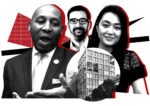It’s easy to sit at a laptop and solve the housing crisis. To actually do it on the battlefield of city politics is anything but.
That is not an excuse for the latest City Council decision to slash apartments from a project proposal. It is, however, a reality-based explanation.
Despite the hopes of pro-housing advocates, it was always a fantasy to expect Shahana Hanif, in her first year representing Gowanus and other Brooklyn neighborhoods, to welcome the 48 units, including 13 affordable, proposed for 153 Ninth Street.
It was, to be sure, in her power to do so. But politicians are wired to compromise — as her office put it Tuesday, to “balance the competing and complex land-use goals of our community.” Especially when they face intense pressure from several fronts, ranging from residents of the block to a top soldier in Mayor Eric Adams’ housing push, Dan Garodnick.
That said, for Hanif to hack the project down to at most 23 units, and perhaps as few as 13, was a painful blow to Garodnick and other housing advocates — one of a thousand cuts that have, over decades, amounted to a bloodletting of the city’s supply of homes.
Could she have done better? Of course. But a rational look at the circumstances makes it completely unsurprising that she didn’t.
Read more



Start with this: Virtually no one gets elected to the City Council on a pro-housing platform. Sure, some candidates make “social housing” a pillar of their campaign, but realize upon getting into office that there’s no pile of subsidy to build it. And having campaigned against Big Real Estate, they won’t spend political capital to let developers build market-rate units that subsidize a lesser number of affordable ones.
Hanif is a fierce advocate, but not for mixed-income housing. Her long list of issues includes helping immigrants, desegregating schools, expanding mental health services and defunding the NYPD by $3 billion.
Hanif would take on the Police Benevolent Association and the Proud Boys, but not Nimbys fixated on “neighborhood character,” advocates claiming apartments would threaten industrial businesses, and, above all, fellow progressives convinced that development displaces rather than absorbs people.
Her campaign website says the affordable housing crisis is “exacerbated by gentrification that’s prioritizing real estate developers over community members.” What that means is anyone’s guess, but it helps explain why she opposed 35 market-rate apartments, even at the edge of long-ago-gentrified Park Slope.
Hanif opposed last year’s sweeping Gowanus rezoning, which was championed by her boss at the time, then-Council member Brad Lander. (Nearly every candidate in her race opposed the rezoning, which will create more than 8,000 units, 3,000 of them income-restricted.)
Having constructed this ideological framework for herself, she could not contemplate the Ninth Street rezoning as an economist would, namely: Where will the 48 households who would have filled those homes go?
They won’t disappear. Instead, they will join bidding wars for other housing. That is what accelerates gentrification and supercharges the competition for affordable units.
What Council members like Hanif see instead are angry constituents demanding she stop for-profit development. They are far more important to her than Garodnick and the mayor, whom she sees not as a Democratic ally but a pro-police enemy. The pro-housing group Open New York urged her to maximize Ninth Street’s housing, but until the organization un-elects someone, Hanif need not fear it.
The political landscape has shifted this year in housing’s favor, in part because some folks on the left finally realized that wealthy people win the bidding wars created by the supply shortage. From the safety of a pundit’s desk, that’s easy to see. For an elected official on the city’s political battlefield, with arrows flying from every direction, not so much.
